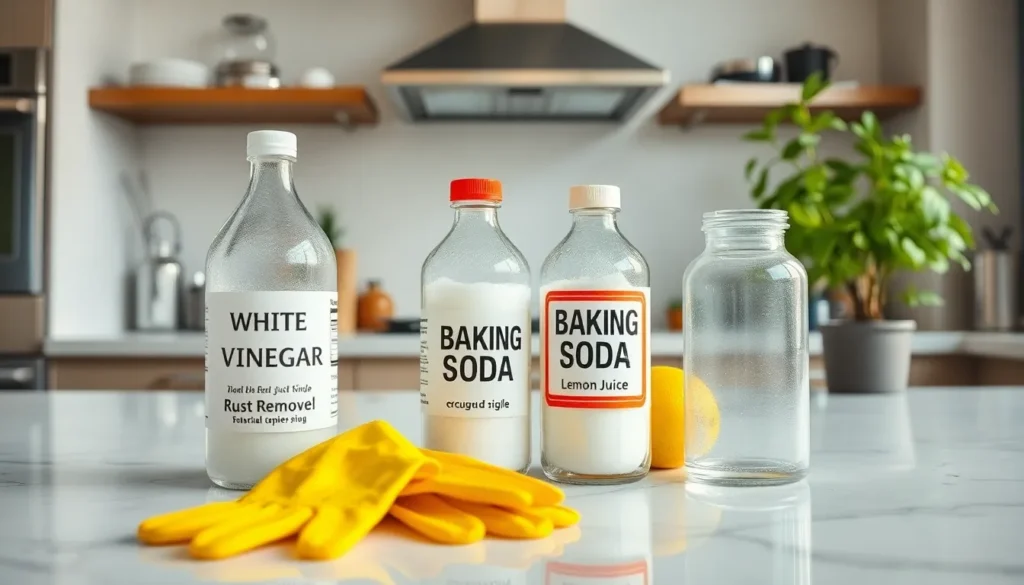Table of Contents
ToggleIf your cast iron pans look like they’ve just staged a wrestling match with a band of rogue rust, it’s time for a showdown. Rust on cast iron is like that unwelcome guest that just won’t leave. But fear not, cleaning cast iron rust is definitely doable. In this guide, we’ll dive deep into understanding how to reclaim your cast iron cookware’s glory. Grab your gloves and let’s get it shining again.
Understanding Cast Iron Care

Taking care of cast iron is like nurturing a wild pet: it requires attention, love, and a little bit of grit. Cast iron cookware is known for its durability and heat retention, making it a kitchen favorite for chefs. Yet, it also demands a specific level of attention to keep it in prime condition. The secret to lasting cast iron lies in proper cleaning and seasoning. Maintaining that rich, non-stick surface is crucial. When treated right, cast iron can be passed down through generations, like an heirloom that cooks your grandma’s famous recipes.
Why Rust Forms on Cast Iron
Rust forms on cast iron for a variety of reasons, primarily stemming from moisture exposure. You see, cast iron is a porous material, meaning it can easily absorb moisture if not properly maintained. Even the smallest bit of water left on the surface can lead to oxidation. Environmental factors play a big role here too. Humidity, for example, can accelerate the rusting process. If one leaves their cookware unseasoned or fails to dry it properly after washing, rust will likely make an appearance before long. It can feel disheartening, think of rust as cast iron’s cry for help.
Essential Tools and Materials
Before embarking on the rust removal journey, it’s crucial to gather the right tools. Here’s a quick checklist:
- Steel wool or sandpaper: Essential for tough rust spots.
- Baking soda: A gentle, yet effective rust remover.
- White vinegar: Works wonders on stubborn rust.
- Mild dish soap: For general cleaning.
- Scrub brush: Perfect for getting into those nooks and crannies.
- Paper towels or a clean cloth: For drying and buffing.
Step-By-Step Cleaning Process
To clean cast iron rust, start by removing the worst of the rust using your steel wool or sandpaper. Buff in circles until you get to the bare metal. Don’t go hardcore, some seasoning might still cling. After that, use soap to get rid of any debris or leftover bits. Rinse thoroughly and dry it completely before proceeding.
Removing Rust with Steel Wool or Sandpaper
This is where the real elbow grease comes into play. Using the finest steel wool or a fine-grit sandpaper, scrub the rust spots firmly. Apply consistent pressure and make sure to cover every rusty area. It might feel like a workout, but soon enough, the shine of the cast iron will begin to reappear.
Using a Baking Soda Solution
If you prefer something a bit gentler, a baking soda solution can work wonders. Mix a tablespoon of baking soda with enough water to form a paste. Generously apply this mixture to the rust spots, let it sit for about an hour, and then scrub clean. Rinse and dry thoroughly.
The Role of Vinegar in Rust Removal
For stubborn rust, vinegar is your new best friend. Soak your cast iron piece in a mixture of equal parts water and white vinegar for about an hour. The acidity will help dissolve the rust. After soaking, scrub with your steel wool until the rust is gone. Rinse and dry thoroughly.
Re-seasoning Your Cast Iron
Once the rust is gone, it’s time to re-season your cast iron. This step is crucial for restoring the protective layer that helps prevent future rust. To re-season, start by applying a thin coat of vegetable oil or shortening. Place your cookware upside down in the oven and bake it at 350°F for about an hour. This process polymerizes the oils, creating a non-stick surface. If you notice some sticky patches, it might mean too much oil was applied, don’t worry. Just buff them out and try again.
Preventing Future Rust Development
Now that your cast iron is sparkling, it’s vital to keep it that way. Always dry your cookware immediately after washing. Leaving it damp is like sending an invitation to rust. Also, regular seasoning, about every few uses, will keep your cast iron in optimal condition. Store your cast iron in a dry place, and consider placing a paper towel inside it to absorb moisture. Being proactive is much easier than battling rust later.










